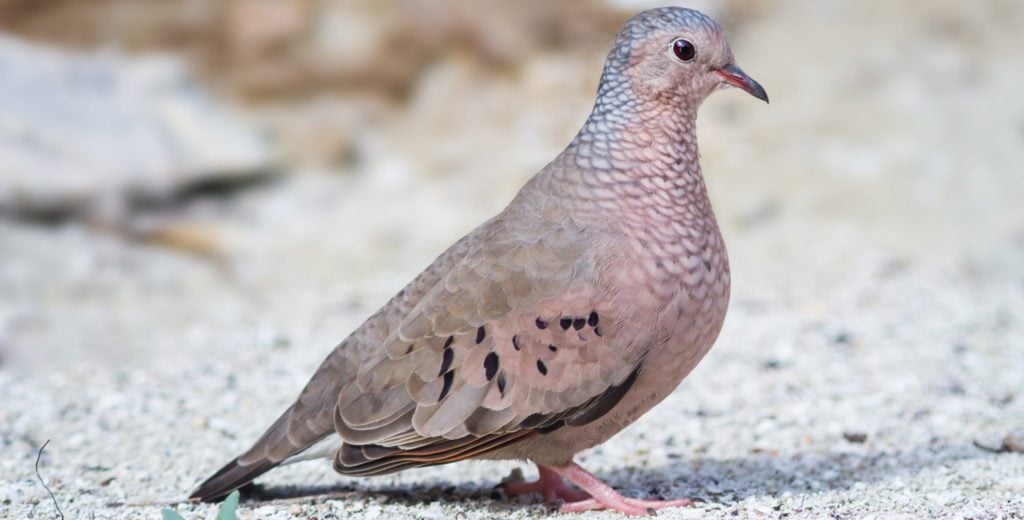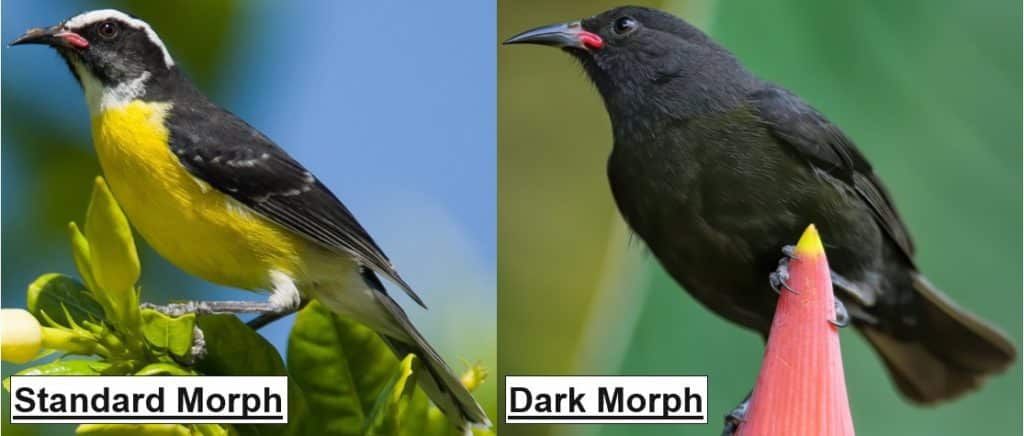11 Types of BIRDS Found on St. Kitts! (COMMON)
Below you will find 11 COMMON BIRDS that live in St. Kitts!

Believe it or not, over 230 species have been observed here, including many birds that only visit during migration. Because of the incredible variety, it would be impossible to list EVERY single type below.
So I did my best to come up with a list of the birds that are seen the MOST. Enjoy! 🙂
Common Birds of St. Kitts:
#1. Yellow-crowned Night Heron
- Nyctanassa violacea

Identifying Characteristics:
- Gray body and yellow legs. Large red eyes.
- Black face with white cheeks and a thick black bill.
- As the name suggests, a yellowish-white crown with long white plumes.
These birds look for areas in St. Kitts with shallow water to live in, such as wooded swamps, marshes, mangroves, and other coastal areas. Yellow-crowned Night-Herons can be found near both fresh and saltwater, and crustaceans (crabs and crayfish) make up most of their diet.
They are comfortable living near humans and will even nest in wooded neighborhoods or rooftops. Also, they are usually easy to see because Yellow-crowned Night-Herons eat and hunt at any time of day.
Upon being disturbed, you will hear a harsh “quawk,” which will probably be repeated a few times. Listen below:
#2. Ruddy Turnstone
- Arenaria interpres

Identifying Characteristics:
- Breeding males have a chestnut and black pattern on the back, similar to a calico cat.
- They have orange legs, which are brighter during the breeding season.
Ruddy Turnstones occupy different habitats each season. They nest along rocky coasts in the Arctic during the breeding season. While migrating, they visit plowed fields and shorelines of lakes. Finally, they congregate on rocky shorelines and beaches in the winter.
These beautiful shorebirds have a unique feeding style that earned them their name. They insert their bills under stones, shells, and other objects, flipping them over to find food underneath. Several Ruddy Turnstones may work together to flip a large object.
They will also probe under seaweed and other debris. Their low center of gravity and special feet with short, sharply curved toenails allow them to walk easily on wet and slippery rocks. WATCH BELOW!

#3. Common Ground Dove
- Columbina passerina

Identifying Characteristics:
- These doves are small, being only slightly larger than a sparrow!
- They have a plain grey-brown back. The underparts have a pinkish tint to them.
- Small heads with a scaled pattern on their breast and neck. Dark spots on the wings.
Common Ground Doves are typically easy to find in St. Kitts. Look for them feeding on the ground beneath bird feeders, cleaning up the grains and other seeds that fall from above.
These doves primarily nest on the ground! Simple nests are built lined with a few types of grass, weeds, and other plant matter. Being on the ground, they can make an easy meal for many predators. Their primary defense is to blend into their surroundings and thick vegetation.
Common Ground Doves are relatively vocal. They can be heard at all times of the day and at any time of the year. Listen for a repeated, soft, high-pitched coo with a rising inflection.
#4. Brown Pelican
- Pelecanus occidentalis

Identifying Characteristics:
- Brown skin on their giant throat patch.
- Dark gray bodies with a white neck and pale yellow head.
- Measures 3.5 – 5 feet in length (1 to 1.5 m) with a wingspan of 6.5 – 7.5 feet (2 to 2.3 m). The weight of adults can range from 4.4 to 11.0 lb (2 to 5 kg).
If you see a pelican in St. Kitts while sitting on a beach, it is most likely a Brown Pelican. These large birds live strictly in saltwater habitats near the ocean’s coastline. Interestingly, they rarely venture into the open ocean, staying within 20 miles of the shore.
It’s a lot of fun watching Brown Pelicans hunting for fish! First, they fly high into the sky and then plunge aggressively headfirst into the water. These dives are meant to stun the surrounding fish, which then are scooped up with their enormous throat pouch and swallowed whole.
Check out the below video to learn more about their insane dives!

And lastly, they birds live a long time. The oldest Brown Pelican on record was 43 years of age!
#5. American Kestrel
- Falco sparverius

The American Kestrel is the smallest bird of prey in St. Kitts.
But don’t let the tiny stature fool you because this raptor is an accomplished hunter. One of their favorite strategies to catch prey is to hover in the breeze from a relatively low height, looking for insects, invertebrates, small rodents, and birds.
Their diverse diet is one reason they can occupy ecological niches from central Alaska down to the southernmost tip of South America. But life can be tough when you’re the smallest falcon since they are sometimes eaten as prey by larger raptors and big snakes!
#6. Bananaquit
- Coereba flaveola

Identifying Characteristics:
- Adults range from 10-13 cm (4-5 in) long.
- Most adults have dark gray upperparts, a black crown, and a yellow chest, belly, and rump.
Bananaquits have something in common with many humans I know – a sweet tooth! Also known as “sugar birds” in St. Kitts, this species is attracted to nectar feeders and bowls of sugar. They even enter homes looking for sweet treats.
Bananaquits are small, colorful, and known for adapting easily to human habitats. They like fruit and nectar, so they spend a lot of time near humans near flower gardens or fruit trees.
This species’ reliance on humans doesn’t stop with their diet. They often build their nests on human-made objects, including lampposts and garden trellises. Look for a globe-shaped tangle of sticks and leaves between 5 and 30 feet (1.5 to 9 m) off the ground.
#7. Magnificent Frigatebird
- Fregata magnificens

Identifying Characteristics:
- Long, narrow wings with a deeply forked tail.
- Males have a red throat patch, which is easily seen during the breeding season.
- Females have a white breast patch.
As the name implies, seeing these seabirds soaring effortlessly in the sky is quite “magnificent.” Using their forked tails to steer, they barely have to flap to stay afloat in the sky.
Due to the fact that their feathers are not waterproof like other seabirds, Magnificent Frigatebirds rarely land in the water and spend almost their entire lives flying. For food, they commonly steal fish from other birds or harass them until they regurgitate their meal, which they grab in midair! Their pirating ways have earned frigatebirds the nickname the “man-o-war bird.”
With Magnificent Frigatebirds, the “early bird” does not get the worm! Most individuals don’t take flight until later in the afternoon when thermals and winds are at their greatest. 🙂
#8. Zenaida Dove
- Zenaida aurita

Identifying Characteristics:
- Approximately 28–30 cm (11–12 in) in length.
- While flying, look for white plumage on the inner part of the wing.
Zenaida Doves look VERY similar to Mourning Doves and inhabit the same ecological niches. The main difference is that Zenaida Doves are smaller overall, slightly darker in color, and have a shorter, more rounded tail. Look for these birds in St. Kitts in open, coastal habitats on the ground, feeding on seeds and grains.
A Zenaida Doves mournful song also sounds similar to a Mourning Dove but is faster in pace. You can listen below!
#9. Gray Kingbird
- Tyrannus dominicensis

Identifying Characteristics:
- Grayish bird with a whitish belly.
- Dark mask on the face that goes through the eye and cheek.
- Tail typically appears notched.
These birds are a lot of fun to watch in St. Kitts!
Gray Kingbirds are bold and expert hunters. They are known to chase dragonflies and other insects for over a hundred yards in spectacular fashion, reminiscent of a fighter pilot!
Gray Kingbirds are fairly easy to find due to their raucous and memorable voice. Listen for a rolling pitirre call anytime throughout the year.
#10. Lesser Antillean Bullfinch
- Loxigilla noctis

Identifying Characteristics:
- Males are black or charcoal-grey with a rusty red throat.
- Females are a drab brownish grey. Rufous coloring appears on the wings.
These birds are common in St. Kitts in various habitats.
Lesser Antillean Bullfinches have adapted well to the presence of humans. They are often seen living in towns and backyards, visiting bird feeders.
Interestingly, Lesser Antillean Bullfinches can breed anytime during the year, although the peak is between April and August.
Their song is a series of 3-7 fast, warbling “tseep” notes. Listen below:
#11. Pearly-eyed Thrasher
- Margarops fuscatus

Identifying Characteristics:
- Mostly brown bird with brownish-white underparts.
- A bright, white eye.
Pearly-eyed Thrashers can be found in St. Kitts in a variety of habitats, including wet and dry forests, open woodlands, scrub, gardens, and urban areas. As far as behavior, they act more like jays than thrashers, often bursting onto the scene noisily in groups, hoping to quickly take any available food.
Their calls and sounds vary from high-pitched whistles to brief chirps to harsh scolding.
Which of these birds have you seen before in St. Kitts?
Leave a COMMENT below! 🙂
Learn about birds on these other islands:
Barbados / Guadeloupe / St. Vincent / Nevis / St. Maarten / St. John

